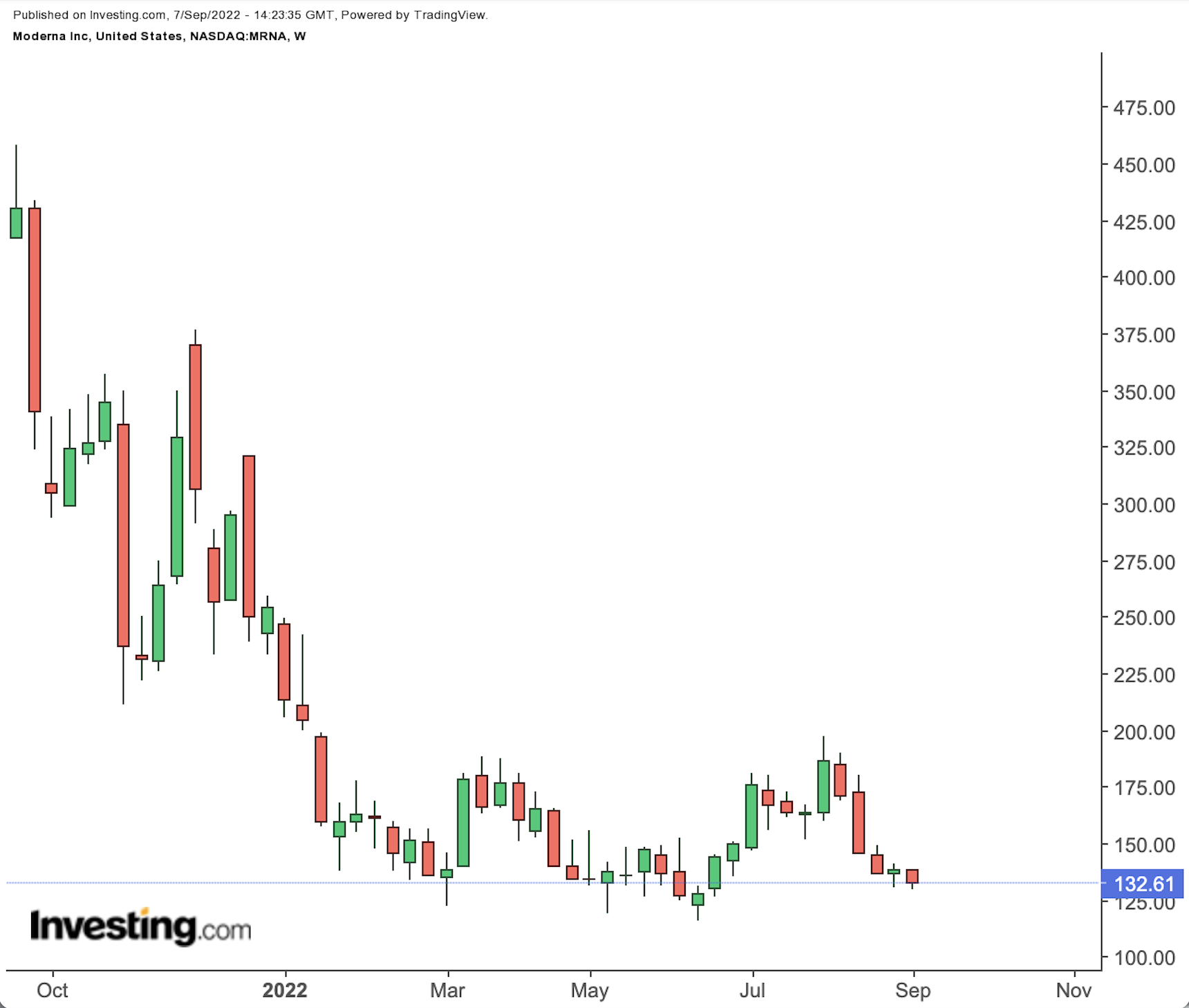- MRNA is an exceptionally difficult stock to value, given enormous uncertainty surrounding its COVID-19 vaccine and other drugs in its pipeline
- But there is a case that an enterprise value still over $35 billion is too high
- Adoption of annual shots and success in the company’s pipeline can change that
Some investors first heard of Moderna (NASDAQ:MRNA) when the novel coronavirus pandemic became apparent in early 2020. But the company was well known to the market before that.
Moderna went public in late 2018. Its initial public offering at the time was the largest in the history of the biotech sector. As a private company, Moderna was valued at about $7 billion. Post-IPO, its valuation was moderately higher.
The company’s focus on mRNA (messenger RNA) technology stoked optimism from investors. It also led to affirmation from the industry, notably through a partnership with – and $125 million in funding from – Merck (NYSE:MRK) to develop a cancer vaccine.
There was real optimism toward Moderna before it developed a coronavirus vaccine in record time. That optimism should still exist at the moment. If anything, Moderna’s success in developing and marketing its Spikevax coronavirus vaccine should strengthen that optimism.
But there’s a catch: valuation. Moderna was valued at nearly $8 billion at the time of its IPO. By the end of 2019, the company’s market cap had dipped closer to $7 billion, including a little over $1 billion in cash, much of which would be spent developing products and gaining approval.
Even with a decline of nearly 75% from an all-time high reached in August 2021, Moderna still has a market capitalization of $51 billion. Its enterprise value, backing out $18 billion in cash and investments and accounting for $4 billion in product deposits, sits at roughly $37 billion.
Since its IPO, Moderna’s enterprise value has increased by about $30 billion. It’s tough to make that math work.

Spikevax Looking Forward
From one perspective, a $37-billion valuation would seem to be a steal. Over the past six quarters, Moderna has generated free cash flow of $16 billion.
But, of course, that stretch coincides with the launch of the vaccine worldwide. Initial demand was strong; that’s no longer the case.
This summer, Moderna itself threw away some 30 million doses. Governments discarded millions more. Moderna itself admitted after second-quarter results that the novel coronavirus has moved into an endemic phase. And it’s not just Moderna: after the launch of its own vaccine, Novavax (NASDAQ:NVAX) last month cut its 2022 revenue outlook by more than half.
It remains to be seen precisely what demand looks like going forward. The U.S. government is expected to recommend annual shots, much like the flu vaccine. But the government also appears unlikely to pay for shots going forward, after a $1.8-billion contract accounted for nearly 10% of Moderna’s guided revenue this year.
Certainly, there’s room for debate. Even the Wall Street analysts who follow the company appear highly uncertain. Earnings-per-share estimates for 2023 range from a profit of $15.39 to a loss of $4.23.
A figure in the middle of that range, assuming minimal growth going forward, could support the current valuation: $8 per share in profit would imply a little over $3 billion in total profit. A 12x multiple (again, assuming minimal growth) gets to that $37-billion valuation, and suggests the company’s pipeline is available essentially for free.
Is The Pipeline Enough?
But $8 per share is far from guaranteed, given where demand is trending. And there are concerns about the pipeline as well.
Moderna’s IPO was well received, certainly. But until the company began developing Spikevax, investors were mostly unimpressed. The company ended 2019 down 15% from its $23 IPO price. Over that same stretch, the SPDR® S&P Biotech ETF (NYSE:XBI) increased 18%.
Moderna does have three products that have reached Phase 3 trials. None necessarily seem like a blockbuster. Vaccines for influenza and RSV (respiratory syncytial virus) face competition. A vaccine for CMV (cytomegalovirus) shows promise, but CMV vaccines have a history of disappointment.
To be sure, there are more than 40 other early-stage candidates in Moderna’s pipeline. But those candidates will require billions in spending, and as with any biotech there’s no guarantee of success.
This can work. Spikevax adoption may surprise to the upside. Success in one of the company’s other products can change the narrative surrounding the stock. Support has held around $120 for much of this year; investors seem to see that level as a price where MRNA stock is too cheap, and long-term those investors may be correct.
But those investors are taking on risk. There’s a lot of uncertainty here, both in Spikevax and in the rest of the portfolio. It’d be nice to see a cheaper price along with that uncertainty.
Disclaimer: As of this writing, Vince Martin has no positions in any securities mentioned.
